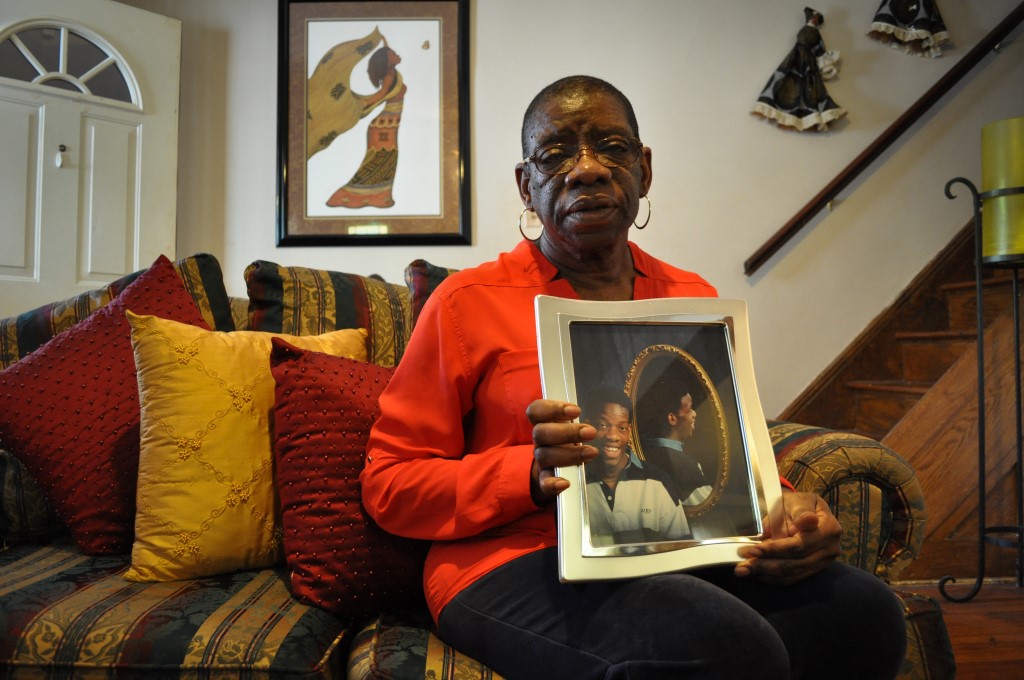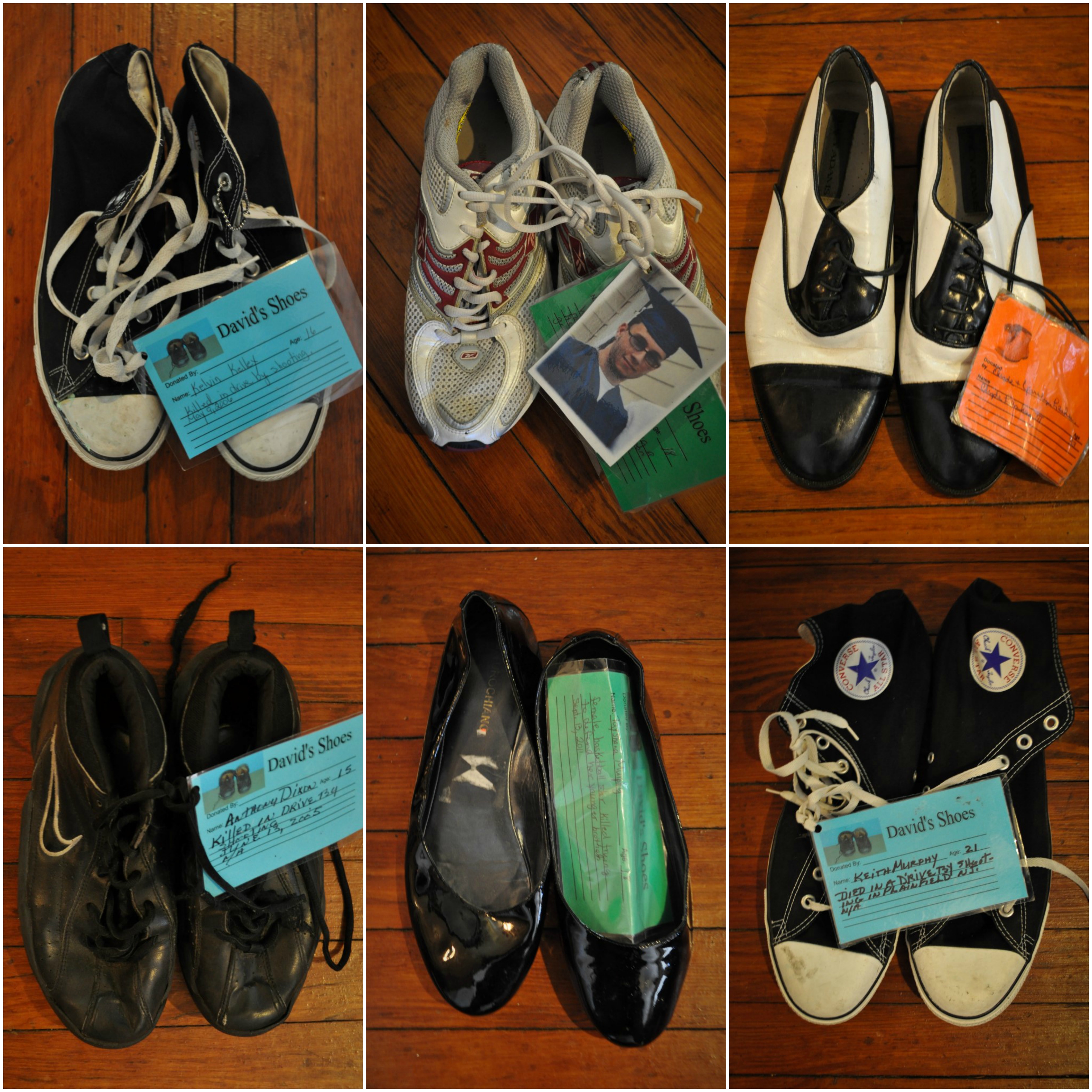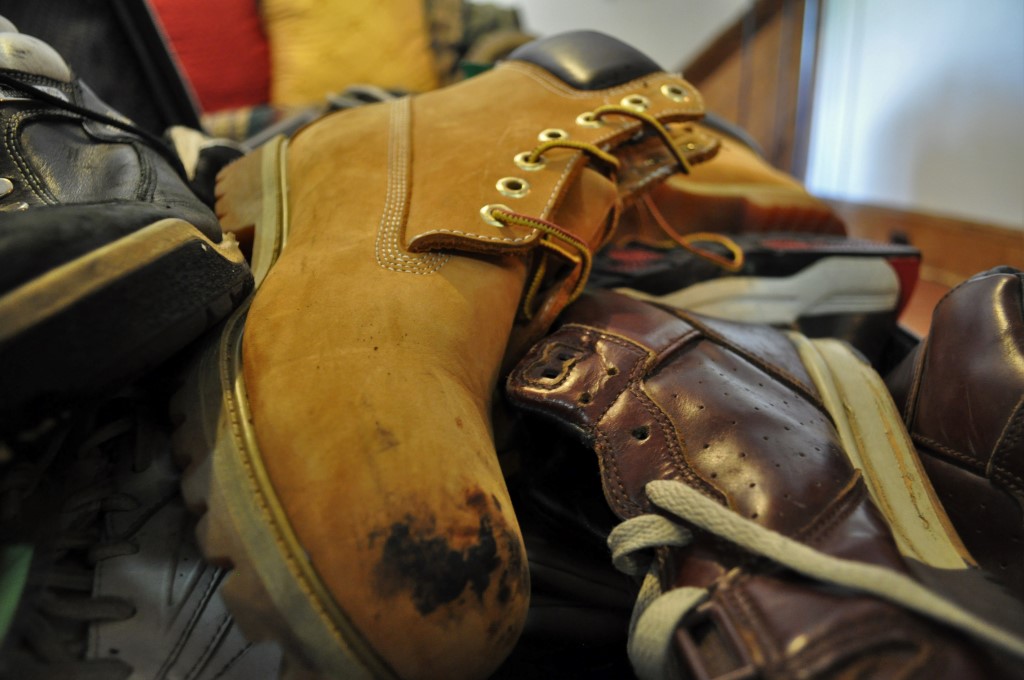One Shoe At A Time
A Mother Turns Pain Into Purpose
The call came just after midnight. It woke Elaine Lane, who had fallen asleep on the sofa in front of the TV in her Irvington, N.J. home. She sat up. Groggy. Still half-asleep when she answered the phone.
It was the call every parent fears. Her son had been shot and killed. “It was like the end of the earth,” Lane said. “It was just pure darkness.”
On that day, March 14, 1998, David Lane joined the 3,792 children and teens killed by guns that year, according to the numbers compiled by the Centers for Disease Control and Prevention. It was a day that warped Elaine Lane’s world, one that would, eventually, prompt her to dedicate her life to humanizing such numbers.
But that took time. “My drug of choice—because you have to numb the pain—my drug of choice was work, sleep, and television,” she said. “It was just devastating, it was absolutely devastating and I felt like I gotta do something. I don’t want another mother to feel what I felt.”
As she began to peel back the layers of grief, over several years of therapy, Lane started working with organizations with a mission to reduce gun violence. But something was missing that left her unsatisfied. She was dealing with stats, but thinking about people. “We as a society, we talk about the numbers, but we don’t talk about the human being,” she said. “We don’t mention their names. Numbers can’t allow you to feel that a human being’s life has been taken.”
Then, in 2005, she visited Newark’s Military Park during the Iraq war and came upon an installation that let her experience first hand the power of objects to humanize loss. The display was composed of shoes—shoes representing men, women, and children who had been killed in the conflict. The installation was so potent. She couldn’t bring herself to explore it further.
“On my way back, I said to myself, ‘If these shoes could affect me this way,” she said. “Then maybe, just maybe, shoes that represent young people, maybe it’ll affect young people.’”
With that in mind, the abstract CDC figures took on new meaning for Lane and she set out to collect 3,792 pairs of shoes. Each pair with their own story, each a physical manifestation of the damage of gun violence.
The collection began with a pair of size 12 leather work boots—shoes that belonged to Lane’s son. From there, David’s Shoes was born—a non-profit with the mission of teaching young people to honor life.

Since the founding of David’s Shoes in 2006, Lane estimates that her collection has grown to more than 400. Lane lugs suitcases packed with Converse high-tops, Air Jordans, and patent leather ballet flats across the tristate area where she speaks to crowds as large as 300 and as small as seven. Through invites and networking, she has visited schools, churches, and “any place where there are kids” to have a conversation about life, loss, and gun violence.
Boxes are left for donations of shoes, which are collected a week later. Some of the pairs had been worn by people who had been gunned down, others donated in memory of such a loved one by a friend or family member. Lane preserves the identities of the person who was shot with neon note tags tied to the laces or tucked under the tongue that record the name, age, and just how they were killed. She can only label ten at a time before it’s too much.
“Sometimes I do have to separate myself,” she said, standing over a suitcase of shoes. “It’s really difficult to see that amount of death.”
To look at Lane’s rows of shoes, the viewer confronts the feet, legs, bodies and faces that once filled them. The loss is tangible. A worn pair of Reeboks are not just sneakers, they are what’s left of Hassan Ferguson after a drive-by shooting. A pair of sand-colored boots keeps Travis Rogers’s memory alive after he was caught in the crossfire of a gang shooting. A smiling graduation photo of Issae Rinas hangs from the laces of his scarlet stripped running shoes—he was shot in the neck on graduation day.
“We need to connect human to human,” Lane said. “We need to see that this is not just a number.” For Lane, David’s Shoes is only one way of communicating that message. “One thing I learned from therapy is you have to open the wound and let it ooze out, let the puss come out,” she said. “As long as I can be verbal and help others, it helps me heal.”

When her story caught the attention of Jeffrey Solomon and Emily Weiner, co-artistic directors and founders of the New York-based theater company Houses on the Moon, Lane was eager to participate in the company’s workshop on gun violence and be a part of its mission to elevate unheard voices.
For three months, participants discussed their experiences, explored storytelling methods, and worked to shape their stories into narratives. Out of this emerged a play inspired by Lane’s relationship to another participant who was convicted of manslaughter. The play, currently titled The Assignment, tracks the relationship between an English professor and a student whose personal essay on an act of street violence reopens buried wounds.
“It represents two people on opposite sides of the spectrum,” said Camilo Almonacid, the playwright of The Assignment, who lost a friend to gun violence. “Theater can be such a powerful way to explore violence. It allows for an intimate encounter. You can’t hit pause, and you can’t change the channel.”
Together the play and stories form gUN COUNTRY, a production that will premiere off Broadway next year and is expected to grow with more stories.
After working with Houses on the Moon and contributing to The Assignment as a participating playwright, Lane noticed a parallel—between the students she speaks with through David’s Shoes and those who participated in the workshops. Both groups seem to have a profound need to have their loss acknowledged and their stories told. She mentioned one teenager whose father was shot and killed. Her grades slipped, she started getting into fights and, eventually, was kicked out of school. “There’s this, ‘Nobody is seeing my hurt, nobody is seeing me cry,’” she said. “When we share grief, when we do it in a community, we all get a piece of that, you know, we’re not doing it alone anymore.”
She has a new way to do that, now, too. Lane plans to host youth workshops. Along with helping people who’ve experienced gun violence to take ownership of their stories, Lane hopes to help steer their lives toward their goals. With her experience as an educator for more than 35 years, Lane is developing the curriculum for a ten week program that will fuse visual art and, if students are receptive to it, the spoken word. Students will create “vision boards,” a web of magazine cutouts, drawings, and photos that will help them visualize their goals – anything from “bringing their grades up from a D to a C, to going to college.” She’s garnered interest from the department of recreation of Orange and Irvington, N.J.
“This problem of gun violence is not just mine even though my son was killed,” she said. “It’s all of our problems. And not unless we feel a sense of ownership will something happen.”
The Impact
One Shoe At A Time: A Mother Turns Pain Into Purpose
An Unsolved Shooting Baffles a Mom for Two Decades
How Grief and Anger Turned Into Action
Silver Gun: A Robbery in Queens
Shooter: “It’s Either Them or Me”
After a Single Dad is Shot, a Community Reels
